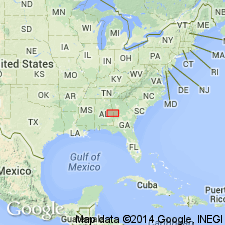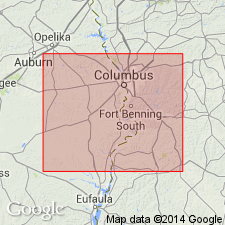
- Usage in publication:
-
- Standing Boy Quartz Diorite
- Modifications:
-
- First used
- Dominant lithology:
-
- Quartz diorite
- AAPG geologic province:
-
- Piedmont-Blue Ridge province
Summary:
Uchee Complex (of Bentley, in press) can be subdivided into at least four units: Mulberry Gneiss, Phenix City Gneiss, Standing Boy Quartz Diorite, and Hudson Rapids Ultramafic Amphibolite. Of the four subdivisions, only the Phenix City Gneiss is discussed in this report.
Source: GNU records (USGS DDS-6; Reston GNULEX).

- Usage in publication:
-
- Standing Boy Quartz Diorite
- Modifications:
-
- Overview
- Dominant lithology:
-
- Quartz diorite
- AAPG geologic province:
-
- Piedmont-Blue Ridge province
Summary:
Name Standing Boy Quartz Diorite of North Columbus Gneiss Complex is credited to Bentley and others (in press). Unit is described here as massive dioritic gneiss, folded stromatic migmatitic gneiss, and well-foliated augen and flaser gneisses. North Columbus [first used here] was upper part of Uchee Complex (not used in this report) and also includes Smith's Road Exit Gneiss and Double Churches Gneiss [both first used]. Unit dominates most of north Columbus, west-central GA, and extends into east-central AL. Age of unit is not stated, but assumed by reviewer to be Late Proterozoic and early Paleozoic.
Source: GNU records (USGS DDS-6; Reston GNULEX).
- Usage in publication:
-
- Standing Boy quartz diorite
GNU Staff, 1993, GNU Staff remark on selected Precambrian units of Georgia and Alabama: U.S. Geological Survey Digital Data Series, DDS-6, 1 CD-ROM., release 3
Summary:
This name has never been formally proposed. Since 1970, it has been credited in all reports to Bentley (in press), The geology of Lee County, Alabama. Unfortunately, the Lee County report was never published. Supposedly there is a 1971 Alabama Geological Survey open-file report by Bentley, Neathery, and Scott that deals with the geology and mineral resources of Lee County. This report, however, is unavailable for review.
Source: GNU records (USGS DDS-6; Reston GNULEX).
For more information, please contact Nancy Stamm, Geologic Names Committee Secretary.
Asterisk (*) indicates published by U.S. Geological Survey authors.
"No current usage" (†) implies that a name has been abandoned or has fallen into disuse. Former usage and, if known, replacement name given in parentheses ( ).
Slash (/) indicates name conflicts with nomenclatural guidelines (CSN, 1933; ACSN, 1961, 1970; NACSN, 1983, 2005, 2021). May be explained within brackets ([ ]).

